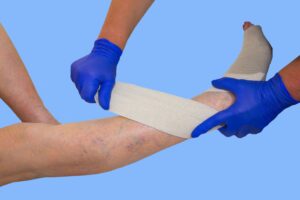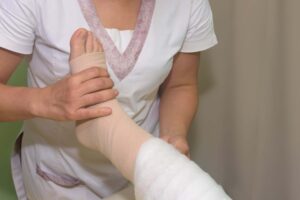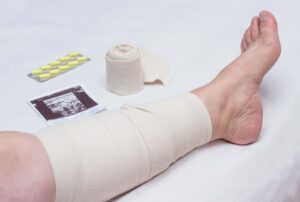Healthcare professionals have used compression therapy to help heal wounds and treat inflammation for centuries. This well-established approach to wound care is the go-to treatment for venous and leg ulcers due to its wide range of applications and benefits. In fact, according to Advances in Skin & Wound Care “Between 50% and 60% of patients heal with compression therapy alone during a 6-month period”.
In light of its crucial role in the healing process, throughout this guide, we will explore how compression therapy works and why it has become so widely used by wound care specialists as another tool to help patients recover.
What is Compression Therapy and How Does It Work?
 Compression therapy is a treatment approach that involves the use of bandages or other wound compression products to improve blood flow circulation in the lower legs. By adding pressure with wraps, it helps prevent fluid buildup, reduce venous pressure and edema, and aids the body in moving blood around.
Compression therapy is a treatment approach that involves the use of bandages or other wound compression products to improve blood flow circulation in the lower legs. By adding pressure with wraps, it helps prevent fluid buildup, reduce venous pressure and edema, and aids the body in moving blood around.
What is Compression Therapy Used For?
A wound care specialist may recommend compression therapy for a number of different injuries caused by poor circulation such as:
- Chronic venous insufficiency (CVI)
- Edema
- Deep vein thrombosis (DVT)
- Leg ulcers and wounds
- Orthostatic hypotension
Let’s take a look at each of these conditions and how compression therapy can help the healing process.
The Benefits of Compression Therapy
 There are a number of reasons why healthcare professionals might utilize compression therapy for circulatory wounds. Some of the major benefits associated with this form of therapy include:
There are a number of reasons why healthcare professionals might utilize compression therapy for circulatory wounds. Some of the major benefits associated with this form of therapy include:
1. Chronic Venous Insufficiency
Chronic venous insufficiency is a common condition. Our leg veins contain valves that help ensure blood moves back up to the heart. When these valves become damaged or weakened it impairs the process, resulting in blood to build up in the legs. If left untreated, the added pressure and decreased range of motion can result in venous ulcers.
By applying appropriate pressure to the leg muscles, compression therapy can help push blood back toward the heart and reduce chronic venous insufficiency.
Compression therapy can also help relieve inflammation and pain associated with varicose veins; a condition that often results from chronic venous insufficiency.
2. Improved Blood Flow and Circulation
Sitting or standing for a prolonged period of time for example after a long flight or forced to stand for work, can impact how blood flows back to the heart. Compression therapy squeezes the leg to help blood flow faster and go where it’s supposed to.
3. Reducing Swelling (Edema) in Legs and Feet
By helping your body absorb extra fluid in your legs compression therapy can be helpful in treating edema, where fluid builds up resulting in inflammation throughout the legs and ankles. Compression wrapping can also help reduce swelling if you have had leg or knee surgery.
4. Managing Symptoms of Orthostatic Hypotension
Orthostatic hypotension is a condition that results from poor blood flow to the heart when you stand up. This can lead to symptoms such as feeling dizzy, lightheaded, or nauseous. In some cases, wound specialists will recommend compression therapy to prevent blood from collecting in your legs (the primary cause of orthostatic hypotension) and avoid these symptoms.
5. Reducing the Risk of Blood Clots
Deep vein thrombosis (DVT) is a condition caused when a blood clot develops in the veins resulting in inflammation and blood to build up. If left untreated, DVT can result in serious complications. Fortunately, compression therapy can also lower the risk of blood clots forming.
Additionally, those that travel long distances can also be at greater risk of blood clots. Wearing compression socks can lower your risk.
6. Treating Leg Ulcers and Open Wounds
Leg ulcers are open wounds that can take a long time to heal. There are a number of conditions where leg ulcers are common including:
- Diabetes
- Hypertension
- Heart disease
- Vein problems
Compression therapy is one of the most common approaches to treating leg ulcers. By improving blood flow, compression therapy helps wounds heal more effectively, reduces symptoms including pain and itching, and can help prevent new ones from forming.
Additional Benefits of Compression Therapy
Compression therapy has also shown promise in:
- Reducing muscle pain and fatigue
- Speeding up muscle recovery
- Increasing flexibility and range of motion
- Reducing the risk of infection
There is no one type of compression therapy that works for everyone and it should be avoided for some types of wounds. For example, it isn’t recommended if you are suffering from peripheral arterial disease, heart failure as well as other conditions. Your wound care specialist will assess your condition to determine if it’s the right choice and help ensure no complications arise.
Types of Compression Therapy Products
 There are several types of compression products that may be used for wound healing. These products are typically broken down by the level of compression they offer. The type you need will depend on your injury and how much compression is required. Generally, less severe conditions such as before a long flight or aching legs require lower levels of pressure, while a higher level of pressure is used to treat acute issues including edema or addressing wounds and ulcers.
There are several types of compression products that may be used for wound healing. These products are typically broken down by the level of compression they offer. The type you need will depend on your injury and how much compression is required. Generally, less severe conditions such as before a long flight or aching legs require lower levels of pressure, while a higher level of pressure is used to treat acute issues including edema or addressing wounds and ulcers.
Compression bandages are typically broken down into Short Stretch Bandages, Long Stretch Bandages, and Multi-Layer Bandages. Long stretch bandages tend to be more elastic and capable of being stretched.
One of the major advantages of utilizing compression bandages is they can be fitted to a wide range of patients. While both short and long term bandages have unique benefits and uses, both have been shown to achieve similar results in terms of healing. Rather, how effective they are will largely depend on how they are wrapped. That’s why it’s so important to consult a trained specialist to gauge how much pressure is needed.
Once your wound has healed, your specialist may recommend compression stockings or socks to help prevent it from coming back. They will measure your legs and recommend an appropriate length (stockings usually reach the knee or thigh).
Although not as common as bandages and stockings, an intermittent pneumatic compression (IPC) system is another method of compression. IPCs utilize a pump and bladder system that are inflated and deflated on a set schedule.
High Quality Wound Care and Treatments
Compression therapy can aid in treating certain chronic wounds, improve healing time and significantly improve overall quality of life. If you or a loved one have suffered a wound and believe you might be a good candidate for compression therapy the expert team at West Coast Wound Center can help. We provide a full spectrum of wound and skin care services, including advanced therapies such as compression devices, and have advanced knowledge in treating a wide range of wound types and skin concerns. Book an appointment today and let us help you heal.
